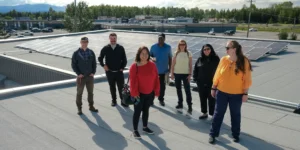
Fort St. John North Peace Museum is saving on energy to invest in programming
Case Study
Published: May 28, 2025
Updated: n/a
Relevant Topics: Policy, Transportation
The North Peace Historical Society installed solar panels on the roof of the museum in Fort St. John as part of a strategic effort to reduce operating costs and channel the annual savings into additional local capacity in support of the organization’s mission.
How did they do it?
- The solar project was driven by a champion on the Society Board who advocated for solar for many years and persevered until it was embedded in the organization’s strategic plan.
- A focused fundraising program involving businesses and a gaming grant offset the initial capital cost. The value proposition was focused on allocating energy savings to additional staff capacity that would allow the Society to enhance its ability to document and preserve the history of the region.
- Support from the Peace Energy Cooperative for planning, installation, and operations.
Published: Sep. 4, 2025
Updated: n/a
Relevant Topics: Solar
Climate Zone: 7
Context
Fort St. John is known as the Energetic City for a reason. While it is perhaps most well-known as the hub for BC’s oil and gas industry, it is also only 14 kilometres away from BC Hydro’s new Site C dam. The community also has a history of involvement in a variety of energy-related initiatives:
- A net zero RCMP detachment completed in 2023 with a 145 kW rooftop solar array
- a micro hydro project to generate power downhill from the City’s wastewater treatment facility
- One of Canada’s first certified single-family passive houses
Fort St. John is located in Climate Zone 7 and experiences colder winters and cooler summers than many parts of BC. It is also relatively sunny, with approximately 2100 hours of sunshine per year.

Contributors

Rob van Adrichem
Director of External Relations
Community Energy Association
Local Realities
Why the Museum Initiated its solar project
The North Peace Historical Society had only one full-time staff member and desired a second staff position to enhance the preservation and presentation of the region’s history. But the Society has access to only two grants that cover the Museum’s operational expenses – a City of Fort St. John fee-for-service grant and a BC Community Gaming grant – and there was little confidence of attracting additional funds from either of them. Instead, the Society aimed to reduce its expenses and eliminate its electricity bill.

Journey to a Solution
The North Peace Museum opened at its current location in 1984. The single-story, 850 square metre facility has a large roof with a south-southwest orientation and no shading.
The Society had been contemplating the idea of solar panels since 2014 but it was considered as a “nice to have” and never seriously advanced. A strategic planning process that began in 2020 aligned a solar project to one of the Society’s main goals: hiring additional staff. Electricity costs were one of the Society’s top 5 annual expenses and allocating these funds to a second staff position would support the Society’s mandate related to the stewardship, research, exhibition, education, and preservation of the history of BC’s North Peace region.
The Society worked with the Peace Energy Cooperative (PEC) to design a solar installation that would completely cover the Museum’s annual electricity consumption. The system would be grid-tied, meaning that the facility would remain connected to the BC Hydro power grid. When the solar panels make more electricity than is needed by the Museum (such as during the summer), the excess power would be sent to the grid. When the facility needs more power than what is being provided by the solar panels (such as during the winter), electricity would be purchased from the grid.
The estimated $85,000 capital cost was offset by local fundraising that secured contributions from Shell, Pembina, Western Financial, Coastal GasLink, and Alliance Pipeline along with a BC Capital Gaming Grant that matched the private donations. With the funding secured, the 29.5kW solar energy system was installed by PEC in May 2024.
The rooftop solar array was designed to offset the Museum’s current annual electricity consumption, but the roof can accommodate a much larger installation. This is prompting the Society to consider implementing a hybrid heating system with a heat pump to reduce the Museum’s natural gas consumption and install more solar panels to offset the additional electricity consumption.

Outcomes
1. Savings
The $4,000 in annual electricity savings are being channelled into a second staff position (part-time for now) and summer student, with plans for an archivist/programmer if additional savings can be realized through the solar initiative along with other sources of funding.
2. Exposure
The solar installation has been well-received by the public and has attracted exposure from tourism organizations that profile sustainability initiatives.
Contributors

Rob van Adrichem
Director of External Relations
Community Energy Association
Funding for this case study provided by:



Related Content
How the District of Mackenzie's failing arena floor led to a whole new solar-powered energy system
The need to replace a failing arena floor in the local rec centre prompted the District of Mackenzie to source external funding that allowed the new arena floor to incorporate a heat recovery system powered by solar panels that is dramatically reducing energy and water consumption, reducing operating costs, and contributing to the longevity of this critical piece of civic infrastructure.

